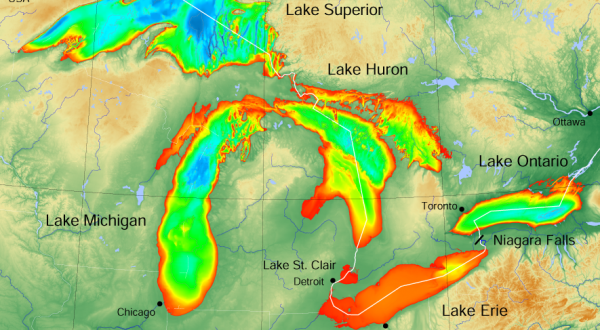14
Feb
Harming Wildlife, Pesticides in Waterways Run into the Great Lakes Year-Round

(Beyond Pesticides, February 14, 2023) The waterways that flow into the Great Lakes are experiencing year-round pesticide contamination that exceeds benchmarks meant to protect aquatic life, according to research published in Environmental Toxicology and Chemistry by scientists at the U.S. Geological Survey (USGS). “What you use makes it into the water,” study coauthor Sam Oliver, PhD, told the Milwaukee Journal Sentinel. These data buttress growing calls from pesticide reform advocates that new laws are needed to protect the nation’s increasingly threatened waters.
USGS scientists conducted their analysis on 16 tributaries that feed into the Great Lakes, including sites that correspond to urban, agricultural, and undeveloped land. Samples were taken at locations closest to the lake the tributary flowed into over a period of roughly one year from October 2015 to September 2016. Each sample was tested for 231 pesticides and their breakdown products. Researchers used aquatic life benchmarks set by the U.S. Environmental Protection Agency (EPA), and created a relative hazard index (RHI) for the study to evaluate whether specific sites should be prioritized for further protections.
Across every sampled tributary, pesticides were found. Accordingly, 96% (190 out of 198) of samples taken contained pesticides or their breakdown products. Scientists detected 104 of the 231 pesticide and breakdown products analyzed, with 80% of samples containing at least 10 different compounds. Herbicides represented the most frequently detected chemicals, with the hormone disrupting weed killer atrazine and its breakdown products (deethylatrazine and hydroxyatrazine) the most common of the bunch, detected in more than 75% of samples. Among insecticides, the neonicotinoids imidacloprid and clothianidin were most frequent, in 44% of samples. The most commonly detected fungicide was carbendazim, found in 51% of test samples. Notably, researchers detected 31 breakdown products that were of unknown hazard that are not captured by current EPA toxicity databases.
The presence of pesticide compounds exceeding aquatic life thresholds was found to occur throughout the entire year. This speaks to the dangers of pesticide breakdown products. The study notes, “For some individual parent pesticides, transformation products extended the ‘exposure season,’ or the proportion of the year that aquatic biota are exposed to pesticides at a given site.” Based on analysis of the samples collected, the toxicity of breakdown products extends exposure hazards an average of nearly two months after the detection of the parent pesticide.
Researchers indicate that human disturbance in the form of urban and agricultural pesticide use represents the most polluted sites, but even samples in undeveloped land along the St. Louis River experience several instances where aquatic toxicity benchmarks are exceeded. The most contaminated site is along the Maumee River that flows into Lake Erie, where 72 different chemicals were detected during the study’s duration.
Prior research shows the Maumee River to be particularly contaminated, with evidence that pesticide use is affecting the fertility of minnows in the stream, though this finding is likely just the tip of the iceberg. Likewise, Lake Erie is perhaps the Great Lake with the most sickened ecology, subject to a long history of contamination and toxic algae blooms.
While agricultural practices appear to correlate with peaking pesticide contamination during the growing season, urban runoff represents a larger overall proportion of the contamination flowing into waterways. With little to no natural soils to filter contamination, and impervious surfaces creating massive outflows of polluted water, this finding is unsurprising. Research conducted by USGS and EPA on urban runoff across the country in 2019 found 215 of 438 sampled toxic compounds present in the water. The sheer number of different chemicals and thus potential for even more toxic mixtures presents significant risks to health and the environment.
It is evident that the toxic soup that many U.S. waterways are carrying is unsustainable and threatens the foundation of many food chains. Imbalances in aquatic environments can ripple throughout the food web, creating trophic cascades that further exacerbate health and environmental damage.
To combat ongoing contamination of our critical waters, we need an all of the above approach to pesticide reform. The passage of the Protect America’s Children from Toxic Pesticides Act, introduced by Senator Cory Booker (D-NJ), is an important step toward these reforms, as it not only addresses EPA malfeasance, but opens up the ability for local communities to pass laws that can protect their unique and threatened landmarks and waterways. Take action today to urge your U.S. Senator to support these commonsense reforms.
Source: Environmental Toxicology and Chemistry, Milwaukee Journal Sentinel










